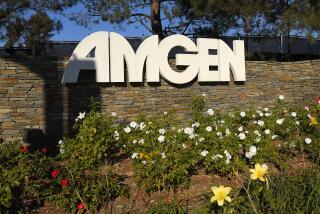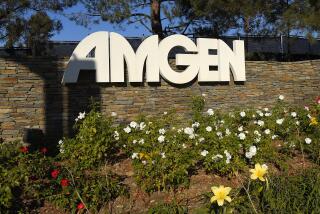FDA Clears Amgen Anemia Treatment
- Share via
The government approved a longer-lasting version of the anemia treatment EPO on Tuesday, giving Amgen Inc. its first significant new drug in a decade.
The Food and Drug Administration approved Aranesp as an alternative to EPO for patients with anemia caused by chronic kidney disease, including those on dialysis. Aranesp is as effective as EPO but can be administered less often, a potential convenience for patients.
Thousand Oaks-based Amgen said it welcomed the long-awaited approval as another sign that the nation is returning to business after last week’s terrorist attacks in Washington and New York. An Amgen scientist, Dora Menchaca, was among those killed on American Airlines Flight 77, which crashed into the Pentagon.
Amgen Chairman and Chief Executive Kevin Sharer has predicted that Aranesp will become Amgen’s best-selling drug, a spot now held by EPO, which posted $1.96 billion in sales last year. Before Aranesp, the only alternative to EPO was a blood transfusion.
The approval of Aranesp sets the stage for a showdown between Amgen and its estranged business ally, Johnson & Johnson. The two firms share the EPO business under an uneasy, 16-year-old marketing agreement. At stake is a worldwide anemia market that Amgen believes will total $10 billion by 2005.
Johnson & Johnson said Tuesday that it immediately set into motion a marketing plan to defend its business. The New Brunswick, N.J.-based company said it already has doubled its EPO sales force and briefed physicians on the differences between EPO and Aranesp.
“We’re fully prepared for the competition,” said Carol Webb, chairwoman of Ortho Biotech, the Johnson & Johnson unit that markets EPO.
Aranesp is an altered form of EPO, a genetically engineered copy of the human protein that spurs red blood cell production. It lasts longer in the bloodstream than EPO, so it does not need to be taken as often. It can be administered by injection once a week or every other week. EPO is given by injection or infusion three times a week.
Aranesp gives Amgen a chance to reclaim business it long ago ceded to Johnson & Johnson when it agreed to split the EPO business. As a young biotechnology company 16 years ago, Amgen retained the U.S. dialysis business, then considered the most lucrative portion. It gave Johnson & Johnson the EPO business in all other markets in the U.S. and Europe.
Together, they made EPO the world’s best-selling biotechnology drug, with total sales of about $4.7 billion.
Amgen said it initially will target patients with chronic kidney disease who are not yet on dialysis. Few of these estimated 6 million kidney disease patients are treated for anemia, the company said. Johnson & Johnson already has one-quarter of this $2.8-billion market.
Amgen said it will price Aranesp on par with Epogen, its brand of EPO, which costs dialysis patients $7,000 to $8,000 annually. Few dialysis patients are expected to switch to Aranesp, however. They receive Epogen with their dialysis treatments, which are administered three times a week. So less frequent anemia treatments are not as important to them.
Amgen could realize $50 million in Aranesp sales this year as physicians begin to substitute it for EPO or prescribe it for new patients, said Fariba Ghodisan of Roth Capital Partners in Los Angeles. She expects Aranesp sales of $324 million next year.
Analysts expect significant off-label use of Aranesp for cancer patients whose ability to produce red blood cells is temporarily impaired by chemotherapy treatments. That is Johnson & Johnson’s most lucrative market; cancer patients account for 68% of the $1.9 billion in annual sales for Procrit, Johnson & Johnson’s brand name for EPO.
Amgen can’t market to cancer patients directly. But it has priced Aranesp in a manner analysts say is tempting. Chemotherapy patients typically receive a dose of Procrit that is one-third higher than the dose administered to kidney disease patients. The dose of Aranesp for all types of patients is roughly equivalent. That makes Aranesp the less expensive choice.
Lehman Bros. analyst Joseph P. Doughtery expects $27.5 million in oncology-related sales of Aranesp this year and $175.7 million in 2002. Amgen said Tuesday that it is seeking approval of Aranesp for cancer, which analysts expect during the third quarter of 2002.
Though Amgen can’t promote Aranesp for cancer, it has funded studies that analysts believe will influence oncologists.
Amgen-sponsored researchers presented results of five studies on the effectiveness of Aranesp at the annual meeting of the American Society of Clinical Oncologists in San Francisco in May, an event attended by 25,000 physicians. Those studies showed that Aranesp was as effective as EPO when taken less frequently than EPO.
Johnson & Johnson, however, made an even bigger splash at the convention. It sponsored a performance by entertainer Tony Bennett for conventioneers and plugged Procrit in ads on cable cars. A paid “speakers bureau” of about 100 medical experts stands ready to discuss what Ortho Biotech’s Webb called “the differences” between Aranesp and EPO. The experts will conduct educational seminars and speak at conventions.
“We have trained our [sales] reps. . . . We have a whole program in place,” she said.
She said Johnson & Johnson is likely to boost Procrit advertising, which totaled $25 million in 2000, according to ad-tracking firm Competitive Media Reports. Amgen spent virtually nothing to plug Epogen, according to CMR data.
Johnson & Johnson has raised several alarms about Aranesp. Basant Sharma, a scientist and Johnson & Johnson vice president, told analysts at a recent meeting that Aranesp has more severe side effects than EPO, including a higher incidence of nausea, shortness of breath and hypertension. And he suggested the altered Aranesp protein could spark an immune response.
But Tony Gringeri, Amgen product development vice president, countered that Johnson & Johnson cherry-picked results from a raft of studies that collectively show the drugs have similar side effects in some patients. He said dialysis patients who have been taking Aranesp for as long as three years have not developed antibodies to it.
“Their concerns are business concerns, not medical concerns,” Gringeri said. “We are competing for the same patients, and they are doing everything they can do to maintain their competitive edge.”
Amgen and Johnson & Johnson have long feuded over the anemia business. Not long after signing the 1985 licensing deal, Amgen accused Johnson & Johnson of poaching in its dialysis business, and the firms revised the deal.
After Amgen developed Aranesp, Johnson & Johnson challenged Amgen in court. It asserted that Aranesp was not a new product but a version of EPO and thus covered by the 1985 marketing agreement. An arbitration panel in 1998 ruled in Amgen’s favor.
Amgen is seeking to terminate the EPO licensing pact, and an arbitration hearing is scheduled for September. Amgen claims that in the early 1990s Johnson & Johnson deliberately sold Procrit in the U.S. dialysis market. Johnson & Johnson said there is no basis for ending its marketing deal and is fighting the accusation.
Johnson & Johnson’s Webb said there is room for both drugs. The oncology and pre-dialysis markets are less than 30% saturated, the company estimates. Beyond that, Amgen and Johnson & Johnson are exploring new applications for anemia treatments, such as in stroke and intensive-care patients, that would further expand their businesses.
The launch of Aranesp and competition between the two companies will create “a lot of noise” in the marketplace that will benefit the firms and patients, Webb said. “More physicians will put more patients on the drug. This will really benefit patients,” she said.
More to Read
Inside the business of entertainment
The Wide Shot brings you news, analysis and insights on everything from streaming wars to production — and what it all means for the future.
You may occasionally receive promotional content from the Los Angeles Times.










